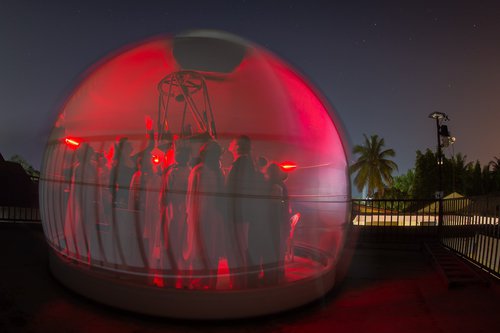Global Jet Watch: discovery of jets in classical novae
 The Global Jet Watch is an innovative project designed and
initiated by Professor Blundell, which consists of five observatories around
the world. These observatories are separated longitudinally to ensure that one
is always in darkness so that information can be collected persistently under night
sky even when other parts of the world are in daytime. This ability to sustain
monitoring allows the research team to follow the lifecycles of different targets
in the Galaxy around the clock, from different locations around the globe.
The Global Jet Watch is an innovative project designed and
initiated by Professor Blundell, which consists of five observatories around
the world. These observatories are separated longitudinally to ensure that one
is always in darkness so that information can be collected persistently under night
sky even when other parts of the world are in daytime. This ability to sustain
monitoring allows the research team to follow the lifecycles of different targets
in the Galaxy around the clock, from different locations around the globe.
One of the types of astronomical phenomena observed by the Global Jet Watch is classical novae, a kind of explosion which occurs when matter is ripped away from the surface of one star onto the surface of a second star known as a white dwarf. This matter then becomes very hot, and the sudden increase in energy creates a light visible to the naked eye, which in the past has been mistaken for the creation of a new star.
During the lockdown in July 2020 a classical nova exploded, and the Global Jet Watch was able to follow it from its world-wide observatories. The spectroscopic analysis of this event and its aftermath, showed that immediately after the explosion jets were launched, consisting of oppositely-directed gas and plasma being squirted into outer space. Previously, these jets had only been detected coming from systems such as black holes and newly collapsed stars, so this constitutes a major discovery.
Using the data from this initial case, the team were then able to look back at four other classical novae they had been observing and found that all four examples showed the same behaviour. This discovery opens exciting doors in astrophysics research, allowing scientists to study the jets as they launch, and to understand their impact within the Milky Way.
Four of the five Global Jet Watch observatories are located in schools, and an important aim of the project is to encourage young people to engage in sciences and engineering through astronomy. In non-lockdown times, students at the schools are able to use the equipment before local bedtime, giving them an invaluable opportunity to observe and operate highly sophisticated technological equipment. It is hoped that this will continue to inspire them to pursue scientific studies, especially for girls in developing countries.
Congratulations to Professor Blundell and the team on this exciting discovery!
For more information, please see the article on the University website: https://www.ox.ac.uk/news/science-blog/global-jet-watch-discovery-jets-classical-novae
For more background on the Global Jet Watch, please visit their website: https://www.globaljetwatch.net/news/what-is-the-global-jet-watch/